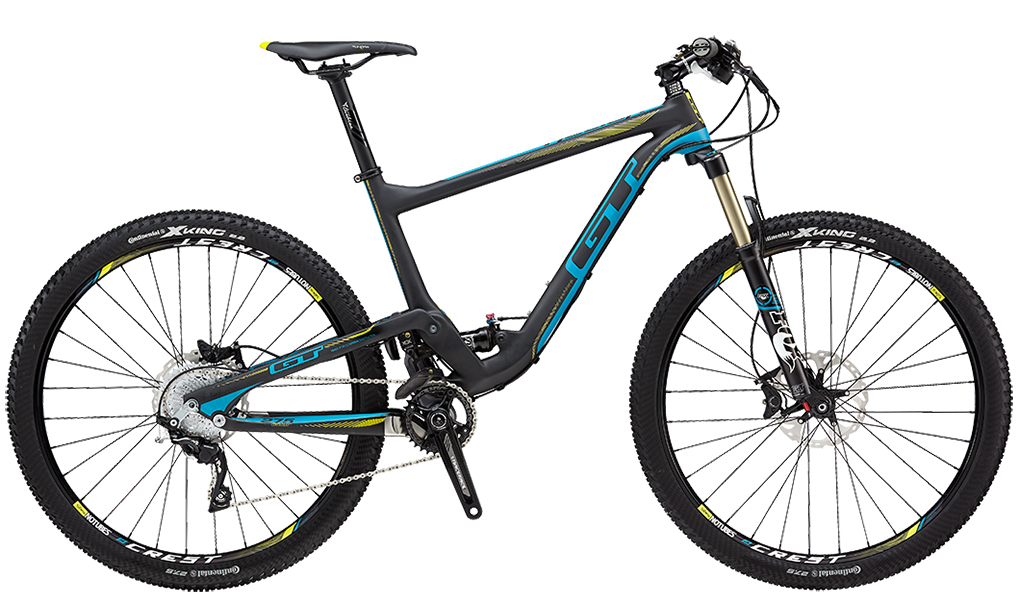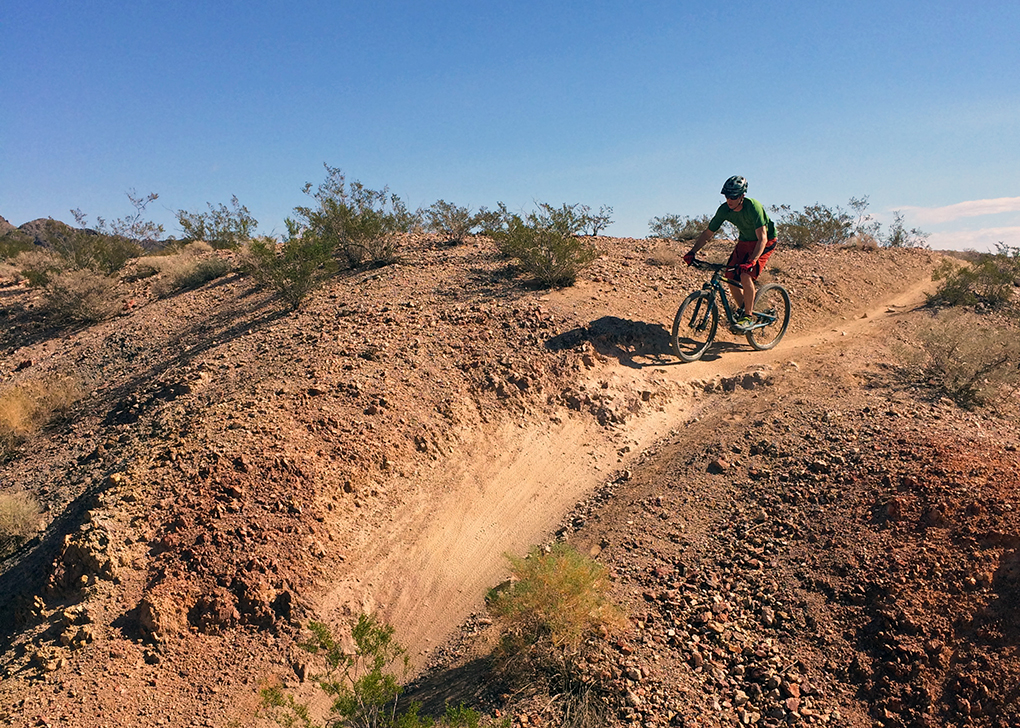Bike: 2015 GT Helion Carbon Pro
Size Tested: Medium
Geometry: See page 2
Complete Build: (Here)
Build Overview:
- Drivetrain: Shimano XT
- Brakes: Shimano XT
- Fork: Fox 32 Float 27.5 CTD FIT
- Shock: Fox Float CTD
Wheels: 27.5″
Travel: 110mm
MSRP: $5,420
Reviewer Info: 5’9”, 155 lbs.
Test Location: Boulder City, Nevada

Caveat
Interbike’s outdoor demo is located at Bootleg Canyon in Boulder City, Nevada. It’s a fantastic network of trails, and it’s a great escape from that wretched hive of filth and villainy that is Las Vegas.
The trails we spent most of our time on were relatively fast, with a fair amount of sand and some pretty rocky sections.
Having said that…
Riding bikes at a demo is always kind of tricky. For starters, we’re unable to get as much time on each bike as we like–our test durations are measured in minutes and hours, not our preferred time frame of weeks and months. One good ride can tell you a lot about how a bike handles, but it certainly doesn’t allow for the customary, in-depth, Blister analysis.
Demo days also don’t generally permit the time needed to get each bike dialed to our liking. A quick suspension setup and fiddling with the bike’s ergonomics gets it most of the way there, but it takes days to really get everything running just right. Furthermore, differences like tire selection and tire pressure can have a huge effect on how a bike rides, and we generally don’t have the chance to get to tinker with those variables too much.
So while we believe it’s important to be upfront about the limitations of reviewing bikes in such settings, there is also merit in riding a slew of bikes, back to back, on the same trail. Subtle differences that might not become apparent if our test rides happen weeks or months apart are able to come to light, and each bike’s attributes may be more easily identified.
With all that in mind, let’s take a look at the GT Helion.
Intro
The Helion Carbon Pro sits at the top of GT’s cross country line, but unlike many of its XC competitors with short travel, the Helion isn’t riding on 29” wagon wheels. As such, it looked like it could be a good option for those who want a bike in this ~110mm travel class and don’t spend a lot of time in situations where larger wheels are an advantage.
The Build
The Helion Carbon Pro, obviously, features a carbon frame. And like many of GT’s shorter-travel bikes, its rear wheel swings around a relatively high pivot. If the Helion were a single-pivot bike, this design would yield a number of less than desirable pedaling characteristics, but that’s not the case thanks to GT’s Independent Drivetrain linkage (which you can read more about in my review of the GT Fury.)
The Carbon Pro build tops the Helion series, but GT offers a number of less expensive builds, all the way down to the $1,680, aluminum-framed Helion Comp.
The Carbon Pro build is outfitted with a Shimano XT drivetrain and brakes, and a pretty nice wheel set: Stan’s Crest rims laced to DT Swiss 240S hubs. Suspension in the rear is handled by a Fox Float CTD, while a Fox Float 32 CTD FIT sits up front.
In a nice gesture, GT also specs the Helion with a remote lockout that actuates both the front and rear CTD switches, making it easy to quickly firm up the bike for sprints, or unlock its dampers for descents.

Geometry & Fit
Many of GT’s more gravity-oriented bikes have longer wheelbases, longer front ends, and slack head tube angles. But the Helion, while it is by no means short, doesn’t have a very long, low, slack stature. Rather, the Helion is fairly middle-of-the-road for what I would classify as an XC-focused trail bike.
The Medium Helion that I rode has a 1090mm (42.9”) wheelbase, which is about 23mms shorter than both the 27.5” wheeled Santa Cruz 5010 (that has slightly longer travel), and the 29” wheeled Specialized Epic (that has slightly shorter travel).
But despite that shorter wheelbase, the Helion has a slightly longer top tube length than those two bikes; the Helion comes in at 606mm (23.9”), while the 5010 is 584mm (23”), and the Epic is 593mm (23.3”).
The Helion’s 69.5° head angle splits the difference between the 5010 (68°) and the Epic (70.5°). The Helion’s chainstay length also falls right in the middle at 438mm (17.2”) vs. 434mm (17.1”) for the 5010, and quite a considerably longer 448mm (17.6”) on the Epic given its larger wheels.
Short-travel 27.5” wheeled bikes aren’t quite as common as longer-travel 27.5” options like the 5010, or 29ers with short travel like the Epic. The Helion is probably most comparable to something like the Giant Anthem 27.5 (review to come), which has slightly shorter chainstays, a slightly shorter top tube, a slightly longer wheelbase, and an identical head tube angle.
The Ride
While geometry numbers don’t always communicate exactly how a bike will ride, the Helion’s numbers are telling, and it does everything it’s supposed to do.
Coming off of some of the more stretched-out bikes with more travel, like the GT Sanction and the Giant Reign, the relatively long top tube on the Helion felt comfortable. I’ve come to prefer longer bikes, because they provide more room to move around when the going gets rough. In the case of the Helion, I was a little concerned that its more stretched-out front end might get a bit tiresome on longer climbs, but unfortunately I didn’t have the chance to confirm this in my time on the bike.
I can say that the bike’s Independent Drivetrain linkage lets it pedal pretty efficiently in general. It feels a little more efficient than the Salsa Horsethief, and about on par with the Giant Anthem. Plus, the handlebar mounted remote lets you quickly switch back and forth between the locked out trail mode, and descend mode, so you won’t lose time riding with the wrong settings.
Considering that the Helion’s travel is relatively short, its suspension seemed to do a good job of taking the edge off of the chunky trails in Bootleg Canyon. The bike’s high pivot location allows the rear wheel to do a pretty good job of getting out of the way of square edged rocks without feeling like its getting overwhelmed. I’d give it the slight edge over the Giant Anthem, but it didn’t like to rally as hard as the Salsa Horsethief (which does have an additional 10mms of travel).
For me, the only unusual, somewhat confusing thing I found about the Helion had to do with it’s wheel size relative to its less aggressive geometry and travel. The Helion runs on 27.5” ‘tweeners, rather than 29ers which again, are more common on bikes with this amount of travel.
In my mind, the 29er debate isn’t much of a live topic anymore, and without wading into a discussion about angle of attack, I’ll just say that on any “cross country” ride, I personally feel more efficient on a 29er. 27.5” wheels don’t provide the same level of efficiency as a 29er when it comes to rolling over rough, chunky terrain.
However, a bike with smaller wheels will typically weave through tight corners a little more quickly and easily, and feel more manageable in steeper, technical terrain, especially when ridden aggressively. 27.5” wheels also tend to be a bit stiffer (and thus more durable), which is a plus if the bike is going to be thrown into corners with reckless abandon.
Given these trade offs, I found myself wondering why the Helion is built around 27.5” wheels instead of 29” ones, since it doesn’t have the slacker angles or the amount of travel that I’d expect to see on a bike that was designed to be ridden hard. In particular, the Helion’s 69.5° head angle is a bit steeper than what I’d prefer if I planned to ride steeper, techier trails. I’d also want more than 110mm of travel, but then again, GT has a Trail and All Mountain line of bikes so, to be fair, it seems that both the Helion’s geometry and the other options in GT’s stable indicate that the Helion wasn’t designed with that sort of riding in mind.
To be fair, there are a number of world class XC racers who have switched to 27.5” wheels, and they seem to be doing just fine. But personally, if I’m going to ride uphill while someone is timing me, or spend a long day pedaling on less-than-gnarly trails, I would prefer to be on a bike with 29” wheels.
Bottom Line
The GT Helion pedals well, is efficient, has a good parts spec, and treads a fine line between 29er XC bikes and more aggressive trail bikes with smaller wheels.
It’s a solid option if you’re looking for a XC or light-duty trail bike, and you either know that you don’t like the way 29” wheels handle, or you’ve found that they don’t hold up well to hard riding.
NEXT PAGE: Geometry

Kind of important omission that CC rivers would be wanting to knw: how much does it weigh?
This bike rips, I demoed it twice last year in the fall once it became available. I rode primarily at a local trail, ascending and descending single trail, needless to say the bike climbs super well. Also, I found it descended super well. The CTD remote switch which allows you to lock out (or stiffen) the front and rear suspension worked well, albeit it feels a bit awkward on the bars. Otherwise I also rode it at a local skills park in a more free-ride/single track environment, the bike also did much better than expected on the descents, however in some more aggressive areas the need for more travel is necessary. However, keeping in mind that this is really a cross country bike, I was stoked on it and get mine in a few days here.
Don’t worry about the long top tube making longer climbs tiresome. This rig is so fast uphill that there is no such thing as a long climb.